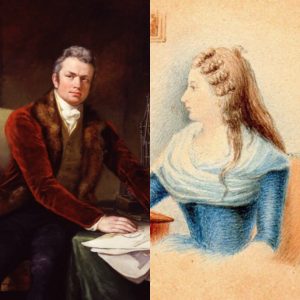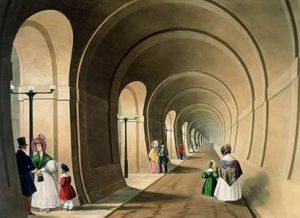The story of the Thames Tunnel is one of perseverance against terrible odds: floods, financial troubles, ill health and death. But at its heart is another story of perseverance, of love triumphing against revolution, imprisonment and ill health. That’s why this Valentine’s Day, we’re sharing the story of Sophia and Marc Brunel.

The starcrossed lovers met against fairly dramatic backdrop of the French revolution. Sophia was born in England, but her brother sent her to Rouen in Northern France, incorrectly thinking the violent clashes were limited to Paris. She stayed with a family called the Carpentiers, where she met a 23-year old Marc Brunel, recently returned from the Navy. Marc insisted it was love at first sight when he met her on 17th January 1793, and never failed to mark the day in the diaries he kept throughout his life.
Despite Madame Carpentier urging propriety, the young lovers were drawn to each other. The political situation was getting more and more fraught. Increasingly violent clashes spread to Rouen. Marc was a known royalist, and often an outspoken and sarcastic one. During a particularly violent riot, Marc abandoned his self control and asked Sophia to marry him, and she said yes.
His situation was becoming increasingly untenable and he needed to leave France. This was not a decision taken lightly as attempting to flee was seen as treason. A passport was forged and Marc sailed to America. For Sophia, as the situation in France deteriorated, all English were imprisoned and she found herself imprisoned in a convent. Later, Sophia would tell her children about her time in the convent. The beds were wooden boards, with a double board for a pillow, and placed touching each other. The food was coarse bread mixed with straw, and there was never enough.
Marc attempted to write, but it is unlikely he would have known of Sophia’s situation until much later. They were eventually reunited in England. When Marc arrived in Plymouth in March 1799, finding Sophia was his first priority. Her great granddaughter recounts that “The lovers used to tell, in after years, of the shock to them both of that first meeting, when each found the other so changed as to be quite unrecognisable.” This did not, however, weaken their devotion to each other. Wasting little time, they were married in Sophia’s parish church of St Andrew’s, Holborn, on November 1st 1799.
The Misfortune
Their marriage, despite the family’s mixed fortunes, seems to have been a happy one, and there are accounts of the couple scandalising society by being obviously affectionate and in love. They had three children survive into adulthood, Sophia, Emma, Isambard. But this was not the end of the trials of the couple. In 1821, Marc was committed to the King’s Bench Prison in Southwark for debt. In later years this episode was referred to by the family as “The Misfortune”. Sophia, “as a good wife did in such cases”, chose to accompany him to prison, “and for two months shared his confinement”. Marc wrote in a letter at the time, “Nothing but the fortitude of my dearest Mrs. B that supports me at all.” Only when it appeared Marc might leave Britain for Russia, taking his engineering idea with him, did the government intervene.

‘Without you, my dear Sophie, no Tunnel’.
The project to build the Thames Tunnel, the first underwater tunnel in the world, was long and stressful. There were frequent floods and the tunnel was closed for seven years due to lack of funds. When tunnelling did begin again, Marc and Sophia would get up in the early hours of the morning. She would wrap him up and light his lamp, and he would go down to the works for an hour or two.
That is until, in June 1839, when he got up at quarter past two, but wrote happily in his diary that he didn’t have to go down to the site, because he “found the report for the night in my new Box of Mrs. Brunel’s contrivance, whereby I obtain my notes in my bedroom – dear Sophia!” This refers to an arrangement by which a bell rang near the bed, he then knew to pull up a basket to the window from outside, that would contain the foreman’s report and a sample of the last excavated soil; after examining it, he wrote his instructions and sent them down by the same means. This examination of the ground took place every two hours, day and night, for at least 4 years. Later in life, when the old couple sat together telling their reminiscences to the younger generation, a favourite description of Sophia’s was of their waking together, their difficulty at first in going to sleep before it was time to wake again, and then, after the habit had been acquired, of their continued waking every two hours for many months after the tunnel had been finished.
When Marc first breaks through with the Thames tunnel, he writes “Rotherhithe, August 12, 1841. Just returned from Wapping by land at two p.m. These are the first lines I have laid on paper of this event, and to my dearest Sophia, I owe this triumph.” And later “Sans toi, ma chère Sophie, point de Tonnelle” which translates as ‘Without you, my dear Sophie, no Tunnel’.
